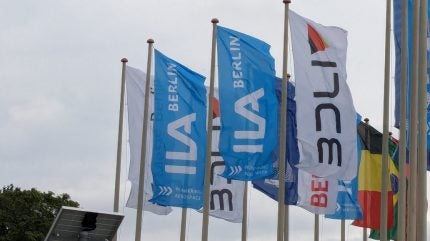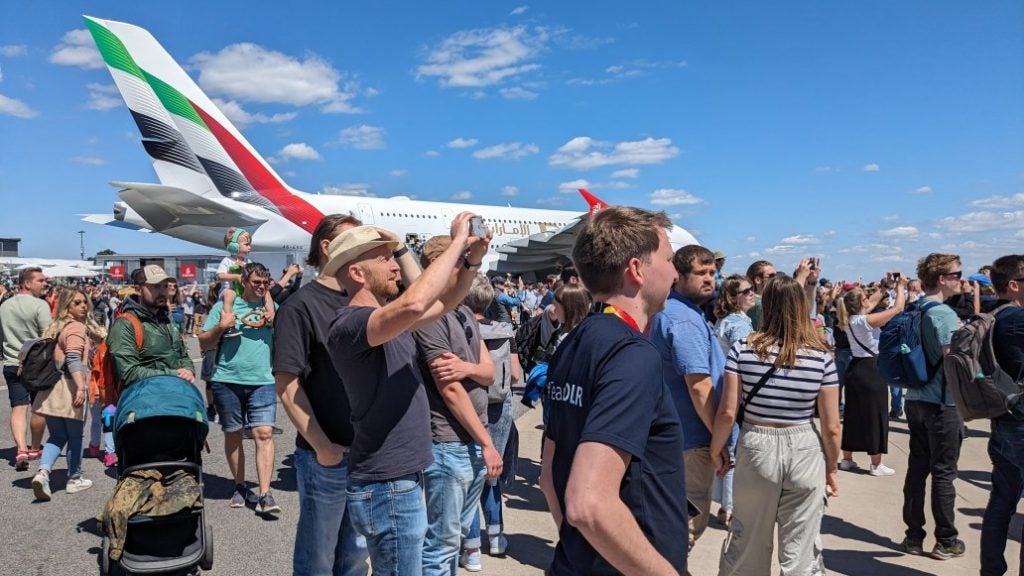
“That’s fuel burn,” CEO of the ZAL Center for Applied Aeronautical Research, Roland Gerhards, remarks, as once again the conversation at ILA Berlin paused for a fighter jet – this time the Eurofighter – passing overhead. Out of sight, perhaps, but such a sound is rarely out of mind.
There is an irony to such interruptions, as the ZAL CEO jokes, we’re gathered in Berlin at this year’s ILA to discuss the future of aviation with a spotlight trained on the sustainability of one of the least environmentally friendly sectors in the world today.

Discover B2B Marketing That Performs
Combine business intelligence and editorial excellence to reach engaged professionals across 36 leading media platforms.
Discussions on hydrogen flight, battery-electric practicalities, and sustainable manufacturing practices are being interrupted by some of the most intensive kerosene burn you’re ever likely to come across.
“Pioneering Aerospace” is the theme of ILA Berlin, but it could equally be termed a crossroads for the past and future.
These events have baked-in dualities. Public vs professional, civil vs military, new vs old. What better city to host than Berlin?
Ein Berliner
Airport Technology landed at the city’s new “unified” Brandenburg Airport – a place that has a new look but doesn’t forget its past. Terminal One looks out over Willy Brandt Plaza. The art installation in the Airport City foyer was taken from the old Tegel airport in the north of the city.

US Tariffs are shifting - will you react or anticipate?
Don’t let policy changes catch you off guard. Stay proactive with real-time data and expert analysis.
By GlobalDataJan-Peter Haack, spokesperson for BER Berlin Brandenburg Willy Brandt Airport – to give it its full title – explained that regular flyers requested the sculpture of Icarus, laying almost pancake-flat and covered in cash, was reused. “It’s a meeting place,” he chuckles, though he says he does understand why the representation of humanity failing to understand its limits and crashing back to Earth might be a curious choice for an airport.
Just like Berlin and its airports, ILA’s history is as much a history of the 20th century as it is of aviation business and the showcase for aviation innovation. The first was held in Frankfurt in 1909, before moving to Berlin and later finding a mid-century home in Hannover. After the reunification of Germany, ILA found its new identity and returned to the old capital.
ILA is now held at Berlin Expo, a purpose-built site for the airshow that is something of an extension to the old Schönefeld airport site. In fact, the site is framed by the BER runways, meaning visitors are treated to numerous commercial take-offs along with the displays they’ve paid to see. It’s the culmination of a plan that did not go as hoped.

BER is the only operational commercial airport serving the German capital, taking over from the now-disused Tegel and the long-abandoned Tempelhof. But ask about how Berlin got here, and you’ll receive a wry smile at best. It’s a long-held (and very unfair) stereotype that Germans lack a sense of humour. But step inside the terminal “museum” at BER and you’ll soon be dispossessed of such a notion.
“BER is the airport with the bizarre history. A functional building that was famous as a debacle even before the first plane took off. This doesn’t make the disaster any less disastrous, but it creates an identity. The smallest building blocks of this identity are the jokes,” a display in the museum states.
The background is complicated, but it’s not avoided. Haack says the spotlight was brighter on BER than if it was not the capital’s airport, but now that the terminals are in full swing, the company is fully focused on technical and technological developments.
“There are no other cities with as many reporters, people with Twitter accounts, and politicians using the airport. So I think we are way more surveilled by the public. Whatever happens here, it’s way more in the focus and that is on the bad and on the good side,” he explains.
BER won’t be competing with the giant hubs of Frankfurt or Munich, so Haack says the growth areas lay elsewhere: “We want to be faster, we want to be smarter, we want to be more digital. Because as a smaller company, airport, you sometimes are faster at introducing new technology… that’s where we see our advantage.”
Hear, hear
Zoom. There goes another one. That one seemed quieter, and it turns out it was. Because that was Airbus with its Neo A321XLR. The pan-European aerospace behemoth is showing that its shiny new aircraft can fly all the way from London to New Delhi. But it’s still loud.
And for Josef Kallo, that’s a deal-breaker. He’s the CEO of H2Fly, one of several proponents of hydrogen flight at ILA24. The company recently proved its hydrogen fuel cell technology with its HY4 demonstrator.
Like so many, it uses a Dornier aircraft, but more of that at a later date. The business’s leader is also a professor, although his oversized glasses are perhaps a good indicator that he’s moved permanently to the corporate world.
There are lots of reasons that Kallo thinks hydrogen power cell technology is the way to go, but the sound output seems most pertinent at this moment. He tells Airport Technology that torque and RPM are vital, and his power train can cut RPM to only 3k compared to 60k in other propellor drives. That means H2Fly can reduce the sound their planes make, which is a gateway to the key bit: marketability.

Kallo is a realist, he doesn’t think H2Fly is the next big thing in long-haul passenger flight. Its goal is the direct A-to-B market, with craft capable of carrying 40-70 passengers. But to make that a reality, there needs to be a change in public perception because, as he explains, we’re going to need a whole new infrastructure of small airports and airfields.
The clearest reason that can’t happen at the moment is noise. There’s just no way that the populations of small towns all over Europe will accept increased use of even existing aerodromes if the noise of modern aircraft is going to come with it. Cut the noise, and suddenly the benefits of short-hop aviation become much clearer.
“We are pushing hard to [upscale],” Kallo explains. “This [existing fuel cell system] is 150kw, so we need six of these and then we have in the region of one megawatt. Based on that, and coupled with a bigger hydrogen storage unit… we will show it is possible to cruise with a 40-seater.”
Yes, there are lots of challenges to overcome, but Kallo says that there is one crucial point that convinces him and his colleagues that hydrogen is the way.
“The physics are with us, not against us,” he explains. It’s a popular sentiment among colleagues. Gerhards made very similar comments, although he stressed “there is no silver bullet” both during panel discussions and in conversation with Airport Technology.
On the dotted line
Is ILA for business? One attendee told us no. It’s much more about seeing old industry friends or meeting new ones. Some things are signed here, but it’s not Paris Air Show, so don’t expect to see Airbus sell 100 units, or launch new civilian projects.
There’s something to that, even if Airbus has actually signed a significant deal with the German Federal Police for a good number of helicopters at this event.
Defence innovation stole the first day of the show, with Airbus Defence and Space’s unveiling of the hyper-futuristic Wingman project, a stealthy UAM that will tie in with the aerospace giant’s FCAS programme and use AI to aid battlefield decision-making. On the civil side, Rohde & Schwarz invited Airport Technology to examine its new generation of body scanners.
Despite what some attendees might experience from their visits, Brandenburg’s elected officials see the promise of new business and are determined to keep ILA at its Berlin base.

“ILA is the largest aerospace trade show in the EU in 2024. It is a great honour for the capital region of Berlin-Brandenburg to host it at BER. By signing the framework agreement on financial participation for the years 2026 to 2030 together with the State of Berlin, we have sent a forward-looking signal to all those involved in future ILAs – this is the right place for the trade show,” insists Dietmar Woidke, Minister-President of Brandenburg.
Back to that baked-in duality of an event like ILA. After three days of industry discussion, business card swaps, and deal announcements, the final days are public and sold out. Many stands are now empty – not everyone can stay for the full 5 days. But the public doesn’t mind, and neither will the organisers, Messe Berlin.
These days are all about the next generation. Talent Hubs take over from sector discussions, attended by gaggles of late-teen students. Airbus and the Bundeswehr – the German armed forces – have brought their full recruitment outfits.
But the average age is brought even lower by the enormous number of small children. Most of them are kitted out with appropriate hearing protection. If Jozef Kallo and his colleagues are right, maybe they will be less necessary in years to come. But there goes a Eurocopter Tiger attack helicopter, proving the sellers of various earplugs right.



